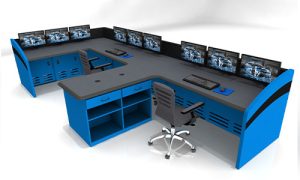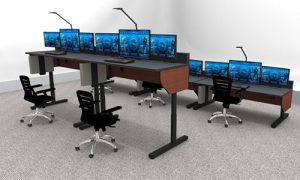Monitor Wall Design In A Technical Control Room


What Is A Monitor Wall?
A monitor wall is an extensive display system made up of multiple individual monitors arranged in a grid and working together to form one large screen. Also known as video walls, monitor walls are typically designed to be used in control rooms and other critical spaces where operators must simultaneously monitor large amounts of data.
Depending on the application, monitor walls can be as large or small as desired. The minimum number of monitors needed is two, while larger displays can be dozens or hundreds of individual monitors linked together, creating massive video walls.
A major benefit to using a monitor wall over a large, single screen is flexibility and scalability. With a modular system of single monitors, you can vary the configuration depending on room size or changing needs. It’s not uncommon to start with a smaller group of monitors and add to it over time as opposed to being constrained to one single large display.
Overall, monitor walls are gaining popularity in niche industries requiring constant surveillance and data monitoring. That and scalability make them a popular option in security centers, law enforcement offices, and technical control rooms.
Considerations When Designing A Monitor Wall
Before designing a monitor wall, several factors must be considered to ensure your configuration will meet your needs. A few of these considerations are:
- What will it be used for? Make sure there is a purpose behind your design. Will it be used for surveillance, data analysis, or something else? Figuring out the purpose of your monitor wall will help you and your sales rep to determine the optimal size, resolution, and number of displays needed.
- The viewing distance. This is the distance between the operators and the monitor wall. Displays must be positioned at the right distance away to avoid eye strain, fatigue, and headaches during long shifts. The distance will also help determine the size and resolution of the displays required.
- The lighting conditions. Another factor is the amount of light that’s in the room. In dim-lit control rooms, displays can use lower brightness and contrast levels. But in well-lit spaces, monitor walls must consider brighter, higher-resolution displays for optimal visibility.
- The type of display technology. Depending on the use case for your monitor wall, you will have several options for the type of display. These options include LCD and LED, OLED, and projection displays. Each has their own pros and cons list, so it’s best to choose the one best suited for your control room and that addresses the previous considerations.
- Resolution. Choosing the optimal resolution of your displays is another important consideration. Naturally, the higher the resolution, the sharper and clearer the displays. Higher-resolution displays have always been typically more expensive. However, the technology behind these monitors has come a long way in the past decade. If you’re on a fixed budget, lower-resolution displays may offer plenty of clarity for your needs.
- The display processor. A monitor wall requires a processor to display multiple video feeds. The type of processor will be dependent on the number of varying displays required and the overall complexity of the monitor wall.

Types Of Display Technology Used In Monitor Walls
One of the most common questions when trying to determine which monitors are best for your display needs is, ‘Which type of display technology should my monitors use?’ There are a few types to choose from, but it will depend on the technical needs of your control room space.
LCD (Liquid Crystal Displays)
LCD technology is a well-known option for monitor walls. LCDs boast a high resolution and decent image quality while remaining relatively inexpensive. And since they come in varying sizes, they are also one of the most versatile options.
LED (Light Emitting Diodes)
LED monitors are another excellent choice for large monitor/video walls since they have consistently-high brightness, contrast, and color accuracy. LED-based displays are energy efficient and have a longer lifespan than other display technologies, making them a reliable option. As far as costs are concerned, LED displays are very affordable.
OLED (Organic Light Emitting Diodes)
OLEDs are a newer type of display technology. They offer superior image quality and color accuracy, and have a very fast response time with regards to processing video. Additionally, OLEDs are extremely thin and lightweight, which allows them to be curved for flexible displays. A major downside to OLED technology is has a shorter lifespan than the other display types, and they come with a higher ticket price.
MicroLED
MicroLED displays are relatively new to the market. Like OLED technology, microLEDs offer bright displays, accurate colors, and high contrast. They also have a very fast response time and are suitable for large-scale monitor walls. However, microLED displays are generally expensive as they require specialized manufacturing techniques. As time goes on and the technology improves, demand increases, etc., prices will eventually come down.
Projection
Projection displays are an alternative option to video walls. Projectors project images onto a wall or large screen. Projection displays are relatively affordable, and although they offer good image quality, they require a darker control room to be most visible. These displays can be upsized without adding monitors, but depending on resolution, they can only scale so much.
The display type you choose is dependent on several factors, including cost. If you’re looking to design a monitor wall but unsure which display type is best, consider speaking to one of our sales reps. Our team is ready to help you design a custom monitor wall for your technical control room today.
Contact Command Watch
For more information on a monitor wall design or to receive a quick quote on command center furniture, control room design, or console accessories, contact Command Watch today.
Contact Information:
(866) 740-2121
cwsales@command-watch.com






